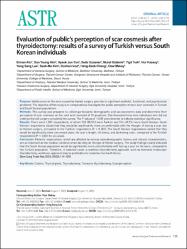| dc.contributor.author | Alçı, Erman | |
| dc.contributor.author | Kim, Soo Young | |
| dc.contributor.author | Yun, Hyeok Jun | |
| dc.contributor.author | Gözener, Seda | |
| dc.contributor.author | Özdemir, Murat | |
| dc.contributor.author | Türk, Yiğit | |
| dc.contributor.author | Hassoy, Hur | |
| dc.contributor.author | Lee, Yong Sang | |
| dc.contributor.author | Kim, Seok-Mo | |
| dc.contributor.author | İçöz, Gökhan | |
| dc.date.accessioned | 2024-08-29T07:51:45Z | |
| dc.date.available | 2024-08-29T07:51:45Z | |
| dc.date.issued | 2023 | en_US |
| dc.identifier.issn | 2288-6575 / 2288-6796 | |
| dc.identifier.uri | https://doi.org/10.4174/astr.2023.105.3.119 | |
| dc.identifier.uri | https://hdl.handle.net/20.500.12462/15089 | |
| dc.description | Alçı, Erman (Balikesir Author) | en_US |
| dc.description.abstract | Purpose: Visible scars on the neck caused by thyroid surgery give rise to significant aesthetic, functional, and psychosocial
problems. The objective of this study is to comparatively investigate the public perception of neck scar cosmesis in Turkish
and South Korean populations.
Methods: This survey was prepared to collect participants’ demographic and socioeconomic data and determine their
perception of scar cosmesis on the neck and consisted of 15 questions. One thousand thirty-nine individuals who did not
undergo thyroid surgery completed the survey. The P-values of <0.05 were deemed to indicate statistical significance.
Results: There were 1,039 respondents, of whom 525 (50.5%) were Turkish and 514 (49.5%) were South Korean. South
Korean respondents stated that they would be significantly more uncomfortable with the thought of having a scar due
to thyroid surgery, compared to the Turkish respondents (P < 0.001). The South Korean respondents stated that they
would be significantly more concerned about the scar’s length, thickness, and darkening color, compared to the Turkish
respondents (P < 0.001 for all cases).
Conclusion: Patients’ expectations, which are affected by various sociodemographic factors and cultural characteristics,
are as important as the medical condition when deciding on the type of thyroid surgery. The study findings clearly indicated
that the South Korean population would be significantly more uncomfortable with having a scar on the neck, compared to
the Turkish population. Therefore, in selected cases, a scarless thyroidectomy approach, such as transoral endoscopic
thyroidectomy, vestibular approach may be preferable for societies like South Korea. | en_US |
| dc.language.iso | eng | en_US |
| dc.publisher | Korean Surgical Society | en_US |
| dc.relation.isversionof | 10.4174/astr.2023.105.3.119 | en_US |
| dc.rights | info:eu-repo/semantics/openAccess | en_US |
| dc.rights | Attribution 3.0 United States | * |
| dc.rights.uri | http://creativecommons.org/licenses/by/3.0/us/ | * |
| dc.subject | Cicatrix | en_US |
| dc.subject | Thyroid Gland | en_US |
| dc.subject | Thyroidectomy | en_US |
| dc.subject | Transoral Thyroidectomy | en_US |
| dc.subject | Scar Perception | en_US |
| dc.title | Evaluation of public's perception of scar cosmesis after thyroidectomy: Results of a survey of Turkish versus South Korean individuals | en_US |
| dc.type | article | en_US |
| dc.relation.journal | Annals of Surgical Treatment and Research | en_US |
| dc.contributor.department | Tıp Fakültesi | en_US |
| dc.contributor.authorID | 0000-0002-3846-7285 | en_US |
| dc.contributor.authorID | 0000-0003-1651-4690 | en_US |
| dc.contributor.authorID | 0000-0002-8234-8718 | en_US |
| dc.contributor.authorID | 0000-0001-6004-0782 | en_US |
| dc.contributor.authorID | 0000-0002-5162-103X | en_US |
| dc.identifier.volume | 105 | en_US |
| dc.identifier.issue | 3 | en_US |
| dc.identifier.startpage | 119 | en_US |
| dc.identifier.endpage | 125 | en_US |
| dc.relation.publicationcategory | Makale - Uluslararası Hakemli Dergi - Kurum Öğretim Elemanı | en_US |




















